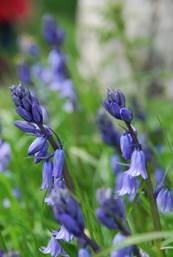Bluebell woods
Over the space of a few weeks in spring, from mid-April onwards, bluebells set our woodlands ablaze with their bright purple-blue flowers. Some of the best displays of these much-loved flowers can be found in woodlands managed by Lincolnshire Wildlife Trust.
Find a bluebell wood near you
What to look for
Bluebells are the start of the show in springtime woodlands but there's lots more to see and hear too. Listen out for woodland birds singing from the branches. Many bluebells woods will be home to birds that have migrated thousands of miles to the UK to breed like the blackcap, willow warbler and chiffchaff.
On the ground look for other woodland wildflowers among the bluebells like the delicate white stars of stitchwort and the unmissable pink spikes of early purple orchids. Remember it’s not just about the colour. The flowers have a distinctive if subtle sweet scent: get down amongst the nodding flower heads and take a deep sniff too!
Identifying bluebells
The recognisable flowers of the bluebell carpet our woodlands in an enchanting sweep of purple every year - a nature spectacle not to be missed.
At a glance, native and Spanish bluebells can easily be dismissed as being the same, but a closer look reveals some simple-to-spot differences that will let you distinguish between the two.

Native bluebells - Rachel Shaw
Native bluebells have:
- narrow leaves, about 1-1.5cm wide
- deep violet-blue (sometimes white), narrow, tubular-bell flowers, with tips that curl back
- flowers on one side of the stem
- distinctly drooping stems
- a sweet scent
- cream-coloured pollen inside

Spanish Bluebell
Spanish bluebells have:
- broad leaves, about 3cm wide
- pale blue (often white or pink), conical-bell flowers, with spreading and open tips
- flowers all around the stem
- upright stems
- no scent
- blue- or pale green-coloured pollen inside
Learn more about bluebells
About
The bluebell spends most of the year as a bulb underground in ancient woodland, only emerging to flower and leaf from April onwards. This early flowering allows it to make the most of the sunlight that is still able to make it to the forest floor habitat, before the canopy becomes too dense. Millions of bulbs may exist in one bluebell wood, causing the blue carpets we so keenly associate with spring, and new plants are sometimes able to split off from these bulbs and grow as clones.
Did you know?
The bluebell's Latin name, Hyacinthoides non-scripta, comes from a Greek myth: when the Prince Hyacinthus died, the tears of the god Apollo spelled the word 'alas' on the petals of the hyacinth flower that sprang up from his blood. Non-scripta means unlettered and distinguishes the bluebell from the similar-looking hyacinth.
Species information
Category
Scientific name
Hyacinthoides non-scripta
Statistics
Height: up to 50cm
Conservation status
Protected in the UK under the Wildlife and Countryside Act, 1981
When to see
April to May
Distribution
Widespread







